Twister chasing in Tornado Alley
Wynnewood, Oklahoma -- As a photographer, the pictures I like taking most are the ones that make people say ‘wow,’ shots that have an emotional and visceral impact on people’s lives. I’ve photographed earthquakes, forest fires and even a volcano, but had never seen a tornado with my own eyes. Until now.
After tons of research, I learned that there is a tornado season -- three to four months a year when they’re prevalent in what’s known as Tornado Alley. And there is an entire culture around these storms -- operators who run storm chasing tours to take people close to the twisters. I settled on a company and booked myself a spot.
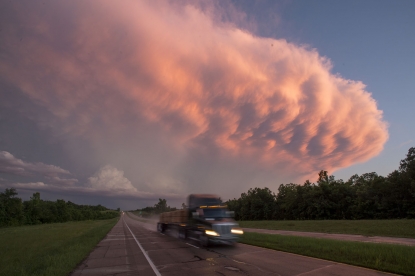 (AFP / Josh Edelson)
(AFP / Josh Edelson)The guy I chose, Roger Hill, has been doing this stuff for 30 years with his Colorado-based company. He is a Guinness World Record holder for the most tornadoes seen by one person -- 630 as of December 2015.
He knows his stuff.
I had no idea what to expect on the trip. A usual storm chasing tour lasts for about seven days and costs 2,700 dollars (the cost is what kept me from doing it earlier).
Turns out to see a tornado, you need to drive. And drive. And drive. And drive. On our tour we had 18 people in three vans and we went as far north as Wyoming and as far south as the Texas-Mexico border.
One of the guys on our tour actually did a log -- we drove 3,221 miles (5,183 kilometers) and spent 77 3/4 hours in the van.
The idea is simple -- whenever a huge storm system is expected to develop, that’s where you go. Interestingly, tornadoes are rare -- a bunch of meteorological conditions have to come together to create one and it doesn’t happen that often.
Our tour was seven days long and in those seven days we did not see a single tornado. Roger said there is usually a 20 percent chance that you go on a storm chasing tour and don’t actually see a tornado.
 (AFP / Josh Edelson)
(AFP / Josh Edelson)On the final day, we were in eastern Colorado, there was a huge storm building and the situation looked promising. But we were an eight-hour drive away from our hotel, people on the tour had to catch flights the next morning, we’d already spent hours driving and Roger didn’t want to have the drivers drive all night. So we turned around and left.
As we drove away, we saw chaser after chaser going the other way. Forty minutes after we left, multiple tornadoes dropped on the very spot where we were. Other chasers were live-streaming it and it was just amazing and we were sitting there in the vans, looking at each other and shaking our heads.
Needless to say, we were all frustrated and depressed. I and seven other people paid to change our flights to stay another day, which happened to be Mother’s Day. So I called my Mom and said “Mom, sorry, but I have to cancel Mother’s Day this year. There is a chance that I could see a tornado if I stay one more day and I really want to try and catch one of these things.” She understood.
The next day, a tornado was close to happening, but didn’t. Another failure.
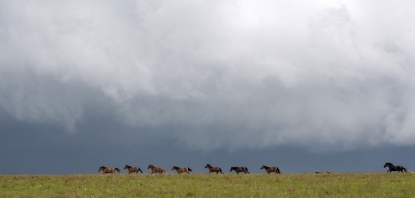 (AFP / Josh Edelson)
(AFP / Josh Edelson)The next day, Monday, looked promising. So I decided to take my chances and again paid to change my flight.
We were about two hours south of Oklahoma City. The weather looked promising and the previous day we had run over a snake in the road, which oddly enough is considered by chasers as good luck. The dew points were high, the air temperature was right, and the models showed several storm systems developing. We stopped at a gas station and basically waited, trying to figure out which system to go after.
There was a thundercloud in the sky. Just a typical thundercloud. You look at it and you think, “Oh, it might rain soon, maybe there’ll be lightning.” And you don’t give it another thought. And then it starts growing. You could actually see it grow -- you know those time-lapse videos? That’s what it looked like. It grew and grew and grew and within 25 minutes it had tripled in size into this gigantic dark monstrosity right over our heads.
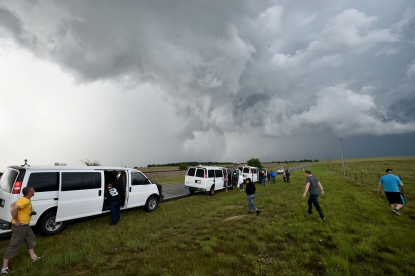 Storm chasers. (AFP / Josh Edelson)
Storm chasers. (AFP / Josh Edelson)Roger thought that a developing system to our south had more potential, so we started driving south. And the system directly over us was getting bigger and bigger and bigger. Then all of the sudden Roger yells, ‘A hook, it’s developing a hook!’
A little meteorology break here. I’m no expert, but what I learned is that tornadoes form when you get warm, moist air from the Gulf of Mexico colliding with cool, dry air from Canada (hence the Tornado Alley smack in the middle of the US).
When the two collide, they create volatility. If you add to that an increase in wind speed and direction, they start dancing in this vicious spin. In storm chasers’ lingo, when a system develops a hook, that means that the system is starting to develop rotation, so there is a higher probability that it could drop a tornado.
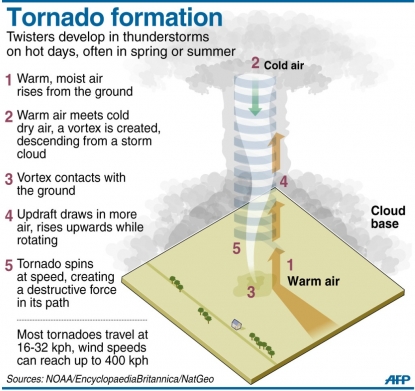 ((AFP Graphics))
((AFP Graphics))So Roger decided to stick with the system above us. We pulled off the freeway on this anywhere road and waited. Within five minutes it got really, really dark. And then we heard his voice on the CB radio -- Tornado! Tornado! Tornado! To your right! To your right!
And there is was. Finally, I saw a real tornado.
 (AFP / Josh Edelson)
(AFP / Josh Edelson)It was off in the distance and it looked like a needle on a record player because it was so far away. I can’t tell you how satisfying it was to finally see one, after all those days and all those miles in the van, but at the same time I thought “That’s it? Doesn’t really look that impressive.”
But then it started getting closer and closer and closer. And within 4-5 minutes, it was coming straight at us and all began to get nervous.
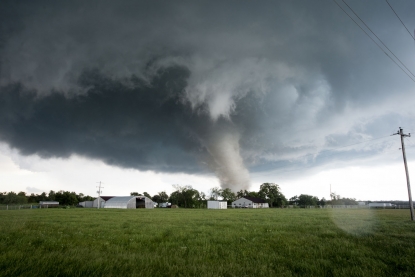 (AFP / Josh Edelson)
(AFP / Josh Edelson)I put on a helmet to protect myself from the golf-ball-sized chunks of hail that were landing all around us. But Roger said, ‘we’re going to be fine,’ so we relaxed and just enjoyed it.
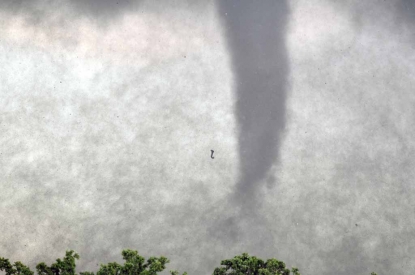 (AFP / Josh Edelson)
(AFP / Josh Edelson)Roger doesn’t just know the tornadoes, he also knows what it’s like to lose someone to one. Three years ago, his good friend and fellow storm chaser Tim Samaras was killed in an Oklahoma twister along with his son and another chaser while doing research.
On that fateful day, Samaras, who was famous for his research on tornadoes and had received grants for his work, and the others ‘punched the core’ -- they went right into the rain and hail system and it changed direction unexpectedly and tragically they died.
Since then, Roger pays even more attention to safety, so as soon as he said “we’re going to be fine,” we relaxed.
As the tornado got closer, you could hear its roar. At one point it crossed a road at what looked like a quarter of a mile from us.
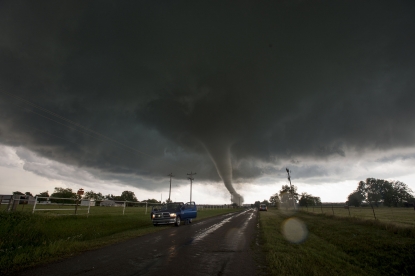 (AFP / Josh Edelson)
(AFP / Josh Edelson)Suddenly there was a huge amount of wind. We were high-fiving and so excited that we finally got to witness one of these things.
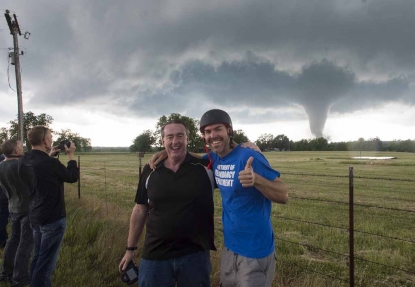 Roger Hill (l) and Josh Edelson celebrate finally catching a tornado. ((Photo courtesy of Josh Edelson))
Roger Hill (l) and Josh Edelson celebrate finally catching a tornado. ((Photo courtesy of Josh Edelson))And Roger said, “Pray for the people, because that debris is pieces of people’s homes. I hope nobody gets killed.”
And that’s the double-edged sword of tornado chasing. On the one hand, you’re thrilled to see one, but on the other hand, it’s destroying people’s houses. You hear the cracking of trees and you realize “those are people’s homes that’s it’s ripping up.”
There was debris and hail everywhere. You could hear the trees being ripped from the ground as they and everything around got sucked into the twister. The thought that someone may be getting killed at that very moment was horrifying. You realize what a small, small thing you are and how powerful this force of nature really is.
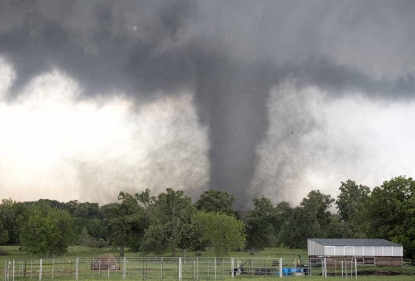 (AFP / Josh Edelson)
(AFP / Josh Edelson)As far as taking pictures, it was a challenging situation. I was soooo excited to finally see one after all these days waiting and all of the sudden I had to think about things like what lens to use, what aperture setting, what shutter speed, the ISO, how to compose the shot. At one point, I was shooting and I realized that for the past five minutes I had been shooting in manual focus and I thought, “Damn, did I just blow the whole thing?” (Luckily I didn’t).
As I was shooting, I tried to also just take it all in. It was just monstrous -- there was no end to it, it just melded into the sky, ominous and otherworldly.
And then it started dissipating. One minute is was this thick black funnel of death and then it turned into this thin elephant trunk dancing along the horizon and then, like a lava lamp, it broke up and was gone. It must have been on the ground for some 30 minutes.
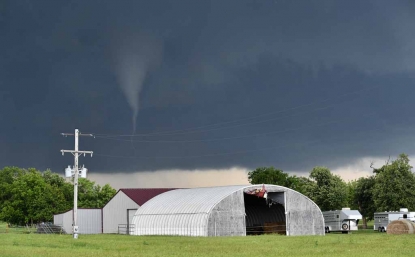 A tornado dissipates. (AFP / Josh Edelson)
A tornado dissipates. (AFP / Josh Edelson)The scary thing about that tornado is that there was no warning. There are tornado warning sirens all over, and IPhone apps and software (that’s partly how Roger and the rest of the storm chasers function) but the warning for this one didn’t go out until it had been on the ground for at least 10-15 minutes. It ended up killing two people and noone knew it was coming.
Two minutes after it disappeared, we got word there was another tornado on the ground not far away. It was huuuuge. That funnel was reportedly a mile wide. There were bolts of lightning everywhere. It looked like God had sent down a giant vacuum cleaner to suck up the Earth. It was wrapped in rain from where we were, so we could barely see it and I didn’t get any pictures of it, but a chaser friend of mine got some incredible shots.
Having a tornado wrapped in rain is the worst thing for storm chasers and the people in danger because you just don’t see the funnel and you don’t know what it’s doing.
And that was it. My last day out there was every bit as intense as you could imagine. It was the most amazing thing that I’ve ever seen. But it was also humbling. You realize what a godly powerful thing a tornado is and it forces you into a state of humbleness. You think “there are people out there in their homes, living their lives and death is knocking on their door and they have no idea what’s coming.”
This blog was written with Yana Dlugy in Paris.
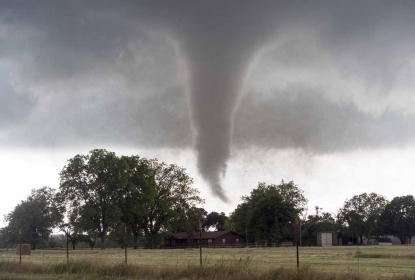 (AFP / Josh Edelson)
(AFP / Josh Edelson)



